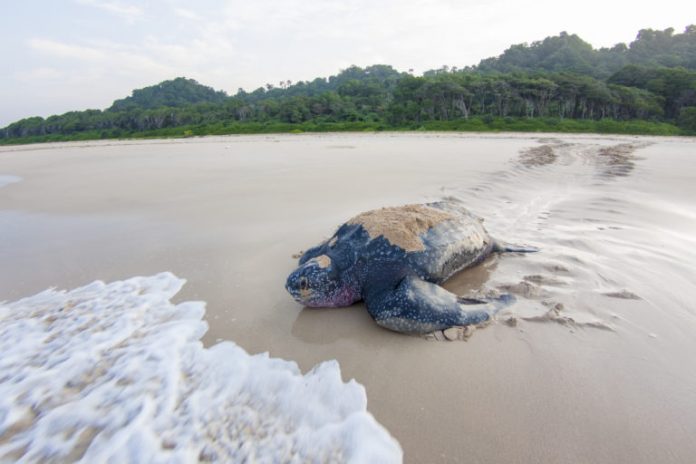
A 58-page, undated “vision document” produced by an Indian government think tank outlines a concept for the “sustainable development” of Little Andaman Island. The rainforested and sparsely populated 675-square-kilometer (260-square-mile) island is part of the remote Andaman and Nicobar Islands archipelago, far off India’s eastern shore in the Bay of Bengal.
The document, not in the public domain but reviewed by Mongabay-India, states that “ecological and environmental constraints” have meant that the strategic and economic potential of the island were never developed to their full potential; 95% of the island is under forest cover. There is need to “open” Little Andaman, which is “as big as Singapore,” and “release the area for deployment of strategic assets,” the document states. The document also draws comparisons with bustling tourist destinations like Bali in Indonesia and Phuket in Thailand. Underlining the Singapore comparison, the vision document says that while the population density of Little Andaman is 47 people per km2, it is 7,615 per km2 in Singapore.
The concept for the island includes development of a city, international airport, marina, ring road with mass transit stations, and tourist centers including hotels, casinos, a theme park, an opera house and an “Exclusive Forest Resort and Nature Healing District” complete with its own airstrip for charter planes and wellness institutes.
“What is stopping us from developing these into veritable jewels for the country?” asks the document, referring to Little Andaman as well as Great Nicobar Island to the south of it, which the report’s authors at the National Institution for Transforming India (NITI) Aayog also propose developing.
However, experts and previous research note that the development of Little Andaman Island would pose a threat to nesting sites of the leatherback turtle (Dermochelys coriacea).
One of seven species of marine turtles globally, of which five are found in Indian waters, the leatherback is the only sea turtle that lacks a bony shell and has a leather-like, flexible carapace; that is what gives it its name. The leatherback is the largest of all living turtles and among the largest of all reptiles. Individuals sometimes grow more than 2 meters (6 feet) in length and can weigh up to a ton, making them much larger than the average human. They achieve this impressive size on a diet of jellyfish. Leatherbacks are found in every ocean except the Arctic and Antarctic, and they are great travelers.
However, many populations of the species have been in sharp decline. Malaysianrookeries that used to host approximately 5,000 nests per year in the 1960s had fewer than 10 nests by the early 2000s. Similar declines have occurred in the eastern Pacific, in Costa Rica and elsewhere.
Adhith Swaminathan, a researcher at the Dakshin Foundation, an environmental and social justice NGO based in Bengaluru, describes the experience of “Tracking a hundred-million-year-old giant” in the April-June 2018 issue of Hornbill magazine. Sri Lanka and India are the only sites in South Asia with large nesting populations of the leatherbacks, he explains in the report. Since 2009, Swaminathan has been part of a research project to assess the recovery of the species after the tsunami of December 2004.
Working with Naveen Namboothri, the Dakshin Foundation’s director, and Kartik Shanker, an ecologist with the Indian Institute of Science in Bengaluru who is associated with the foundation, Swaminathan monitored nesting sites and tagged 10 leatherbacks using satellite transmitters. One turtle covered 13,000 km (8,080 miles) from Little Andaman to the coast of Mozambique in 266 days, swimming about 50 km (31 miles) each day. A majority of the tracked turtles moved from Little Andaman toward Southeast Asia, with one reaching Australia.
Scientists gathered data on nests and biometric measurements, with information on time of nesting, duration of egg-laying, clutch size and tide. They tagged adults so they could identify individuals.
In June 2019, in their latest report to the government, the scientists write that the leatherbacks have two high-intensity nesting sites on Little Andaman: on South Bay and on West Bay. “The monitoring indicates that leatherback nesting on beaches of Little Andaman Island has recovered substantially after the 2004 tsunami,” the scientists report. The team could not use satellite trackers after 2016, for lack of funds, but will deploy them again as part of an ongoing project.

Conserving marine turtles
In a letter dated Jan. 19, 2021, Prakash Javadekar, India’s environment minister, noted: “Besides being home to one of the largest congregations of nesting of the Olive Ridley Turtles, five species of marine turtles are found in India. These species found in Indian marine waters have been listed in Schedule 1 of the Wildlife Protection Act, 1972, and therefore, accorded very high protection status.” He was writing as part of an introductory note to the government’s National Marine Turtle Action Plan for 2021 to 2026. This 24-page document aims to identify threats to these marine species and offers a list of activities to be undertaken to mitigate them. Among activities to be initiated this year are to collate and organize existing data on threats; establish baseline data collection and monitoring programs; and determine which populations are affected by incidental capture in fisheries and other sources of mortality.
Sea turtles are slow-maturing, long-lived animals. There should ideally be long-term studies to better understand them, according to Swaminathan’s Hornbill article. The marine turtle action plan document offers a road map for such studies, but only for five years. However, if the plan according to the NITI Aayog vision document for Little Andaman is implemented, many wildlife researchers and environment experts familiar with the island fear that the leatherbacks, which have swum across the oceans for millions of years, will be pushed one step closer to extinction.
In a January 2021 meeting of the standing committee of the National Board for Wildlife, chaired by Javadekar, the committee discussed stripping the Galathea Bay sanctuary on Great Nicobar Island of its protections. The committee directed that a comprehensive management plan for conservation and protection of leatherback turtles on Great Nicobar Island be prepared and followed by the Andaman and Nicobar administration, which governs the archipelago. The meeting minutes noted that the administration “shall bring more areas under conservation of the leatherback turtle.”
Home of the Onge tribe
Survival International, an international NGO promoting tribal peoples’ rights, lists the Onge as the native tribe of Little Andaman. Until the 1940s, this tribe comprised the sole permanent residents of the island. There are now nearly 18,000 settlers on the island, and the Onge have been restricted to a cramped reserve. Survival International puts the Onge’s population at just 112, having dwindled over the years.
Social scientist Pankaj Sekhsaria, who has been studying the Andaman and Nicobar Islands for two decades, noted that this region falls within India’s Seismic Zone V, among the world’s most active seismic zones. The December 2004 tsunami was caused by an earthquake not far away.
“While it is nobody’s case that the entire land mass should be denuded of forest cover and the tribes relegated to the dustbin of history, there is surely a compelling case for clearing up some of the land,” states the vision document, quoting an Indian official.
A forest officer, in a private communication to a senior forest department official regarding the proposed development of Little Andaman that Mongabay-India accessed, wrote that more than 2.4 million trees and 1.6 million rattan plants (family Arecaceae), whose canes are used in construction and crafts, as well as other vegetation now cover the area the document proposes to develop. “The proposed area for diversion spreads over vast tract of forests having undulating configuration,” the official wrote. “Geologically the island is very recent and the area is prone to soil erosion. The existing forest cover provides the binding force to hold the sub-surface with soil. The forest type is tropical rainforest and the island receives about 2020 to 3774 mm of rainfall annually distributed over eight months and removal of forest cover will lead to severe top soil erosion.”
The forest officer also cited a 2002 judgment by India’s Supreme Court that ordered the closure of sawmills and removal of encroachments in the archipelago, seeking the preservation of the islands’ biodiversity and calling for the immediate suspension of tree felling. The court barred the planting of oil palms and returned the land allotted for it to the forest department.
“This being the island ecosystem, such large diversion of forest land shall have obvious environmental loss leading to irreversible damage,” the forest officer warned.
This article has been authored by Rosamma Thomas
This article was originally published in Mongabay.












